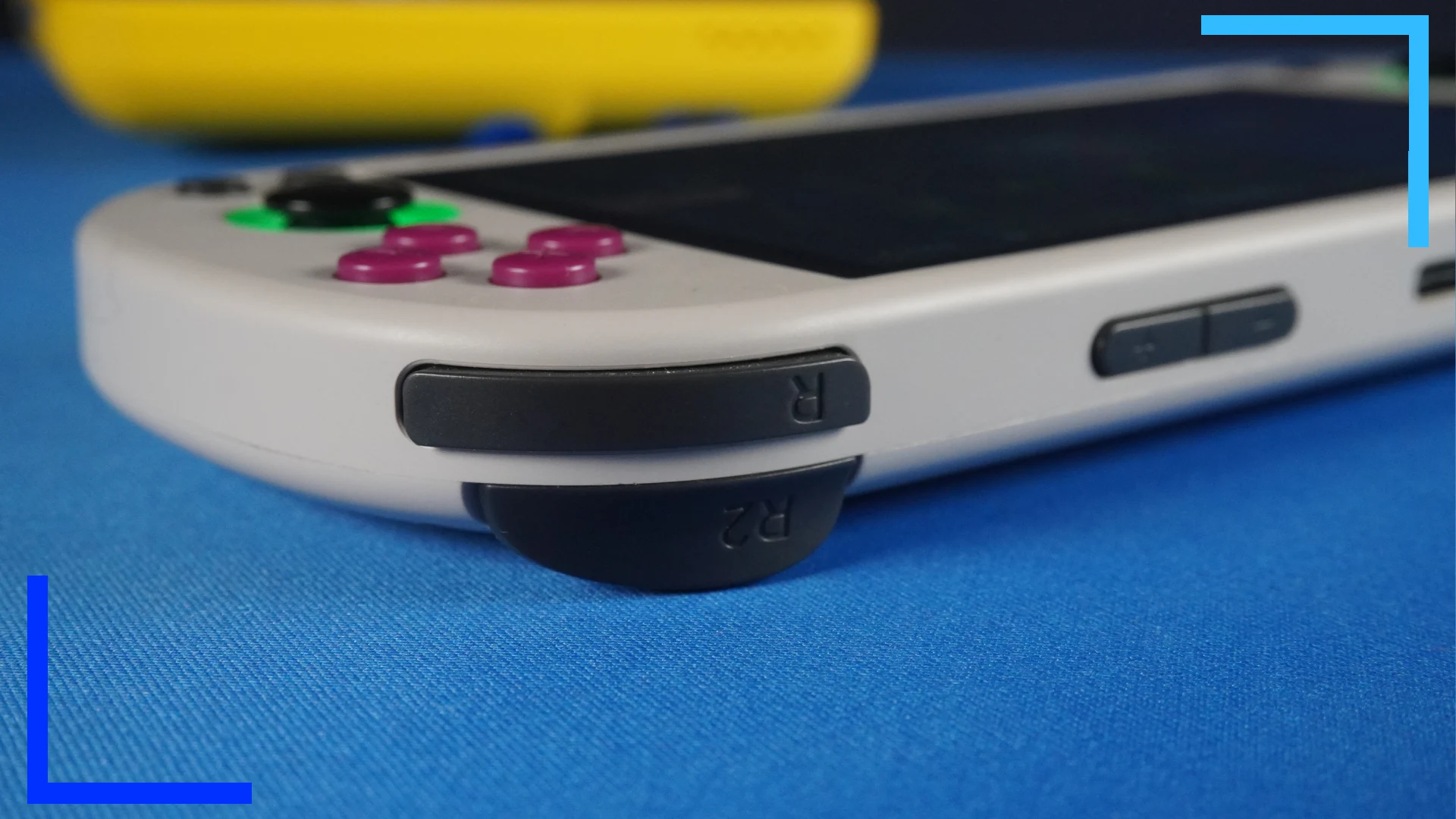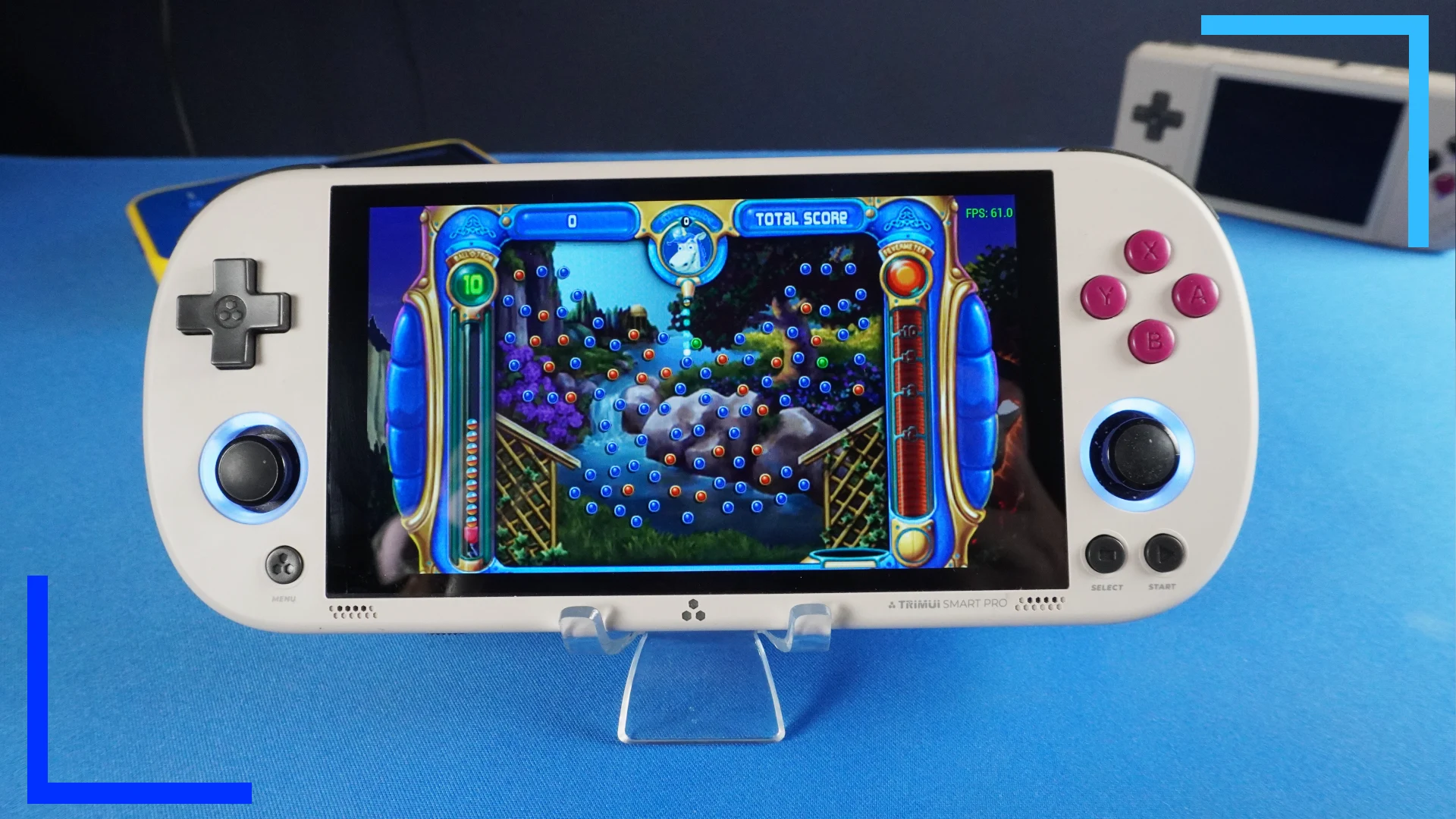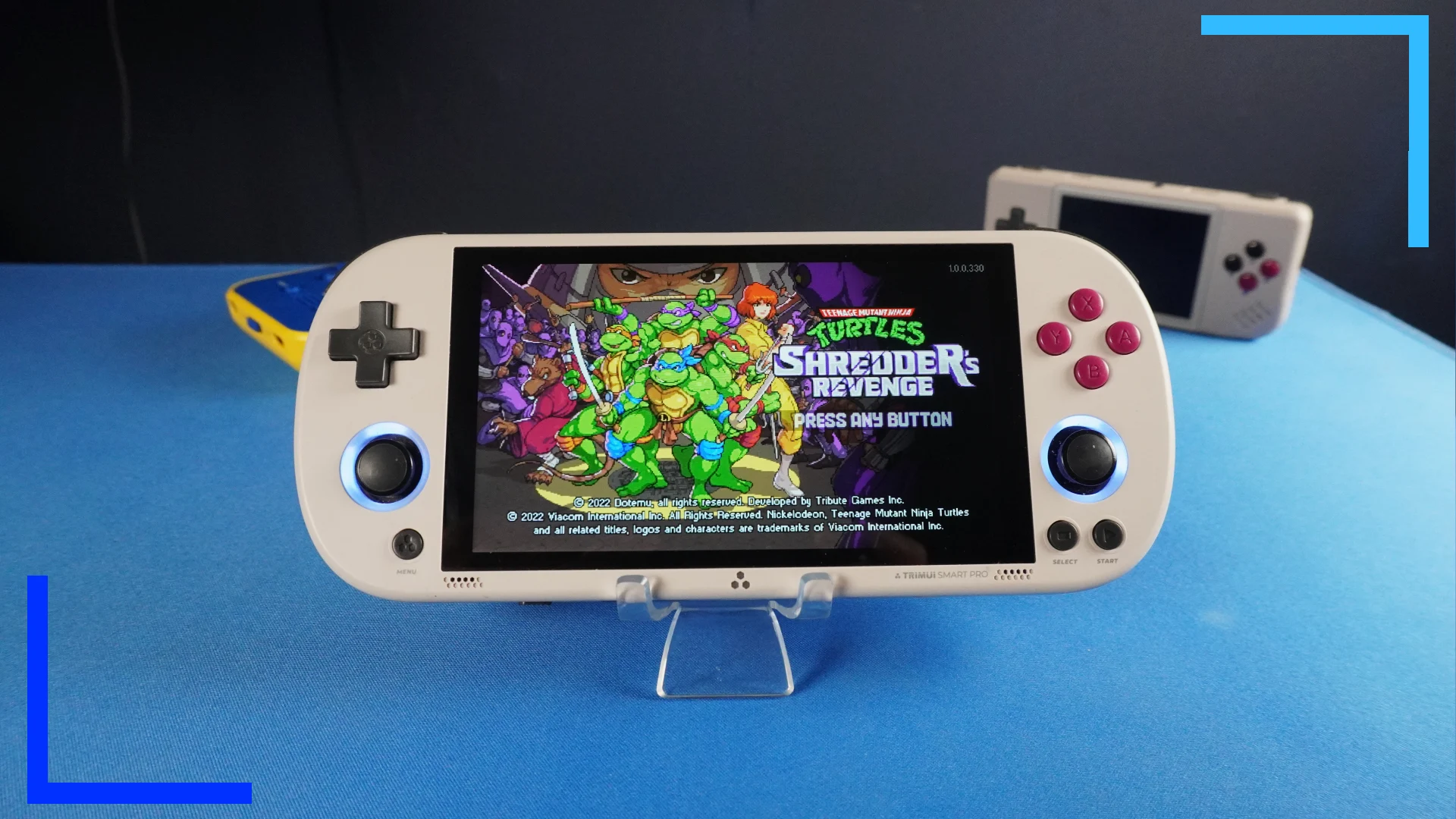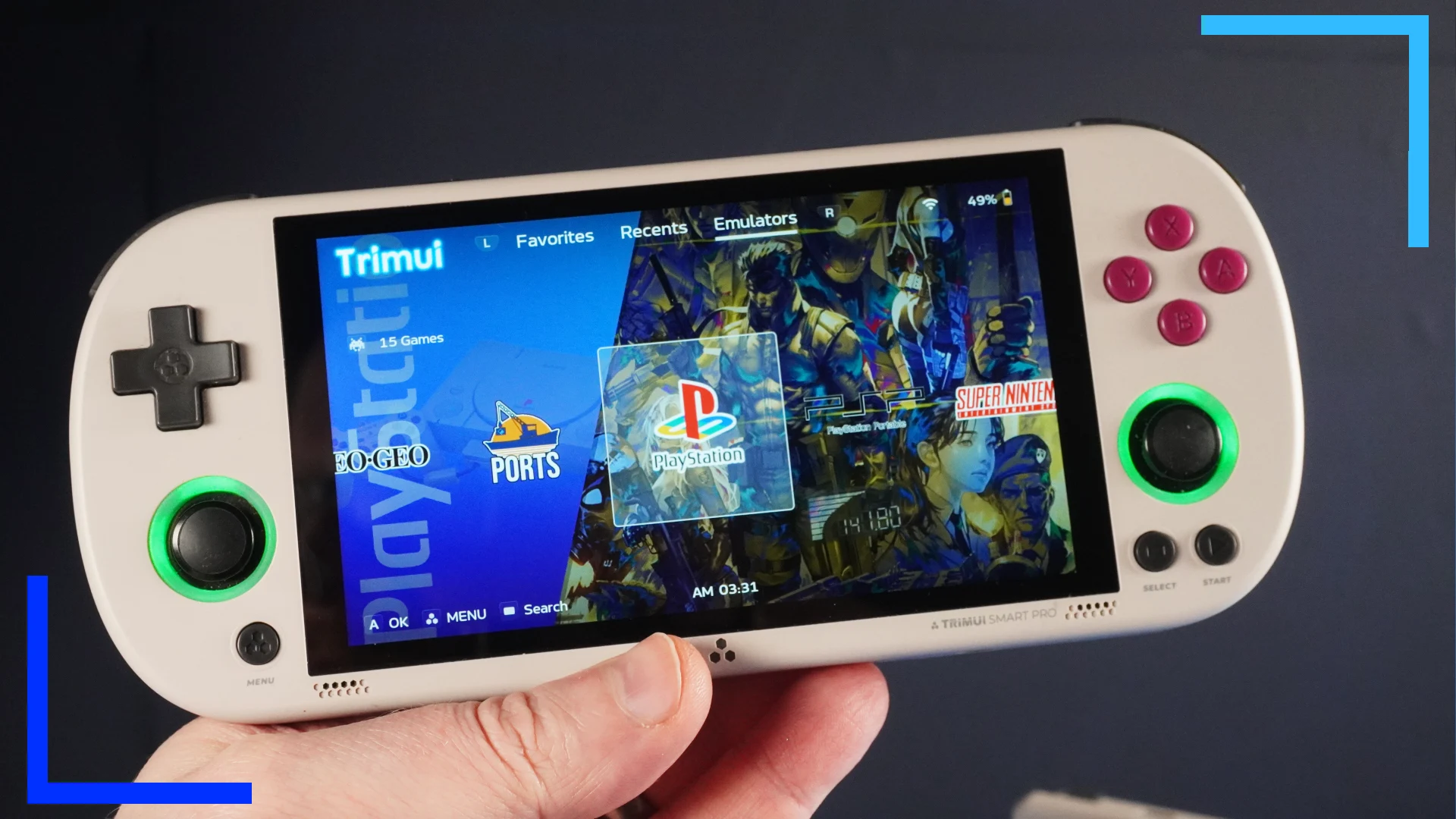Price at time of review: $48/£33.
As one of the cheapest retro handhelds out there, it’s hard to believe what this device is capable of. Old-school retro, some newer systems, select modern indie games, the TrimUI Smart Pro is a better prospect than many of the devices that cost twice as much.
How good is this super-budget device? Read on to find out what I make of the follow up to the TrimUI Smart and why this device is one console every handheld enthusiast needs to own.
Design



Let’s start with the d-pad. The feel of the click is satisfying and gives just enough feedback to let the user know when they’ve fully pressed a button without feeling like you have to exert pressure to get a response.
For platformers, moving forwards and backwards isn’t an issue, but I did find there isn’t enough of a rocking motion when you press down then move the down section slightly to the right or left. It’s most noticeable in fighting games. Trying to pull off a quarter-circle input is possible, but it’s not consistent. I’d say about every eight times out of 10 it’ll work, but there are moments where it simply won’t register the input as intended.
Moving on to the thumbsticks, things become a little more troublesome. Using the stock operating system to check button inputs doesn’t throw up any problems, but if you load up the PPSSPP emulator and use that to check button inputs, you’ll see what the problem is. For some reason, the left stick can register directions as half inputs instead of full.
Imagine pushing all the way to the right but the stick only responds with half of that. If a game needs a left or right input, it’s fine. But any game that uses precise inputs becomes unplayable. In Peggle on PSP, trying to move the crosshair felt like I was moving in slow motion because of how long it’d take to perform a simple movement of the cursor. This problem also makes playing fighting games a pain as you can’t properly escape attacks.
There is some good news, though. I’ve worked out how to fix the thumbstick problem, albeit temporarily.
Head into the Settings tab (the far right menu) and then click on System. From here, click on Calibrate Joystick and follow the on-screen instructions.
One thing to note, this does occasionally stop working. When that happens, repeat the steps above and it’ll fix it until the next time.
Let’s switch things up a bit and talk about something more positive: The face buttons are fantastic. I normally dislike smaller face buttons, but here it’s clearly an intentional design choice. Due to where your thumb rests, you’re able to press the Y button with the tip, and the B button with the lower pad near where your thumb bends. It’s the same for the X and A buttons. The buttons are smaller to reduce travel distance and that choice works well. Not just that, the buttons offer up an exquisite amount of bounce, resulting in a near-perfect amount of feedback.
The stacked shoulder buttons also feel natural to use. I never felt like I was reaching for one button and accidentally hitting another. The triggers being slightly diagonally lower than the bumpers also helps to navigate finger movements more intuitively.
Another solid design choice is having the Menu button below the left stick and Start and Select below the right. Because of the ergonomics of the device, placing the buttons below the sticks means you won’t be hitting them accidentally. In the 100 hours of using the TrimUI Smart Pro, I’ve never once pressed them when reaching for another button.
The rounded shape of the device mirrors that of the PS Vita, although thanks to the matte finish on the back of the device, I surprisingly find the TrimUI Smart Pro more comfortable to hold. Obviously comfort is down to each person and what works for them, but for me, I can’t think of a device I prefer holding. The only slight issue is the back-right of the Smart Pro can get hot when playing the more advanced systems like PSP, N64, or Dreamcast. For every other system, the heat gain is negligible. But those more powerful systems do heat up the Allwinner A133P CPU chipset.
Emulation Performance


The TrimUI Smart Pro can play up to PSP, but that comes with more caveats than a Silicon Valley contract. PSP does work, just don’t expect anywhere near 100 percent coverage or fullspeed on every title.
It’s PSP where the Allwinner A133P chipset is pushed to its limits. What’s interesting is, due to the nature of the PPSSPP emulator, there’s a lot of room for improvement if you’re willing to dive into the settings and play around. For most players, I’d suggest looking at PSP as high-end games that will run with painfully low framerates, while the more lightweight apps are fully playable with occasional hiccups. But for those happy to tinker, it’s possible to play some of the more advanced games if you’re willing to drop the visual quality. I wasn’t able to get God of War Ghosts of Sparta or Tekken 6 — two notoriously difficult games to run — to a point I was happy with, but games like Peggle, arcade classics, and Soul Calibur can be played and enjoyed with minimal fuss.
| TrimUI Smart Pro Specs | |
| Operating System | Linux |
| Colors | Black / White / Gray |
| Screen Size | 4.96-inch IPS Screen |
| Resolution | 1280×720 |
| CPU | Allwinner A133P |
| RAM | 1GB LPDDR4 |
| Storage | 8GB eMMC |
| Connectivity | WiFi, (Bluetooth was added in the latest update) |
| Battery | 5000mAh |
N64 and Dreamcast both face similar problems. High-end games often require a bit more work, but I found more games were playable out of the box compared with PSP.
I also need to note, to get the best performance, make sure the FN button on the bottom of the TrimUI Smart Pro is set to the higher clockspeed and is turned on. You don’t need this setting on with PS1 and below, but it will make a difference with the harder-to-run titles.
Another quick point, Sega Saturn is a no-go. That system needs a decent amount of power to run and isn’t possible at this price point, not that I think anyone was expecting it to be.
As for PS1, SNES, Genesis/Mega Drive, and the other collection of retro systems, they all run well. You can even get away with turning integer scaling on if you want to scale the image somewhat. Game Boy Advance, in particular, looks stunning on the slightly unsaturated TrimUI Smart Pro’s 4.96-inch IPS 1280×720 screen.
Operating Systems



The stock operating system does its job but lacks any real kind of visual appeal. It’s comparable with the Anbernic ARC-D in that regard, but TrimUI knew people would want to alter it, and that’s the Smart Pro’s secret weapon.
For a start, you can sideload apps. Want a scraper to pull box art? How about custom boot animations? You can do all that thanks to some excellent community support.
The real game-changer, however, comes in the form of custom operating systems, of which you’ve got the choice of CrossMIX-OS, MinUI, or Knulli. Personally, I’d recommend Knulli for people who’ve used EmulationStation before, and for everyone else, CrossMIX-OS.
I’ve been using CrossMIX-OS for a while now and to say it transforms the TrimUI Smart Pro would be an understatement. The custom firmware comes equipped with a host of different apps including System Tools, configurable LEDs, and a selection of themes that change how the system looks. I’ve currently got a Nintendo Switch style of design on my Smart Pro and it looks great.
More importantly, CrossMIX-OS also installs Portmaster, which is its own reason to buy the TrimUI Smart Pro. For those who don’t know, Portmaster is a piece of software that gets lightweight Linux games running on Alllwinner chipsets.
What does that mean in a more tangible sense? Thanks to Portmaster, I’ve been playing TMNT Shredder’s Revenge, Stardew Valley, Sonic Mania, Balatro, and Star Wars Jedi Knight 2 on the TrimUI Smart Pro — a device those games were never meant to run on. And that’s all thanks to Portmaster. Yes, you can play Stardew Valley on a $50 handheld as long as you own the PC version. If that’s not impressive, I don’t know what is.
There is some technical knowhow when it comes to getting the files from the PC game itself, but most of the time it’s ‘copy this folder and paste it onto the SD card’. Plus the Portmaster app tells you how to install them and, while on the TrimUI Smart Pro, only shows you which games should work.
Obviously most people will want the device for emulation, and that’s fair. But given how versatile this super-budget handheld is, it’s worth branching out into custom firmware like CrossMIX-OS and apps like Portmaster if you want to get the most out of your Smart Pro. Trust me, you won’t regret it.
Alternatives
Due to how affordable the TrimUI Smart Pro is, it’s hard to recommend anything else at this price point. The closest would be the Anbernic ARC-D at $62/£40. That handheld has similar performance but switches out the PS Vita-inspired design for that of a Sega Saturn controller. There’s also the RG35XX Plus ($42/£40) if you want a Game Boy design with the same performance.
If you want more power — namely cleaner Dreamcast and most PS2 games — there’s the Retroid Pocket 4 Pro ($192/£155) but that does cost a lot more, and when getting into that kind of price territory, I recommend going with the AYN Odin 2 at $279/£220 over anything else thanks to how powerful it is and the ease of use of the Android operating system. AYN also make the PS Vita-shaped AYN Odin 2 Mini if you really want to keep the aesthetic, although that will set you back a whopping $319/£252.
Verdict


When you compare the TrimUI Smart Pro with any other retro handheld available, you instantly see just how much value is packed into its super-budget price tag. It’s not without its faults, but those faults are so insignificant in the grand scheme of things that it’s pros far outweigh the cons.
If you want to play old-school retro games on a screen that is great for the price, select games from more advanced systems like PSP and N64, and some modern indie games to boot, all with a customizable operating system, the TrimUI Smart Pro does all that and more.
For the price, it is the standard when it comes to budget retro handhelds.
How I Tested
During my 100 hours plus with the TrimUI Smart Pro, I played a range of different emulators spanning everything from the 8-bit era up to PSP. I also installed a custom operating system — CrossMIX-OS — and tested that out to see whether it would damage the device in any way (it didn’t).
I also suffered zero faults with the hardware itself, and no other issues with the stock operating system outside of the problems listed in the main review.
I depleted the battery several times to test for faults as well. Battery life varies depending on the game being played, but as a general rule, I would average around six hours with the higher clockspeed turned off, and between four to six hours with the clockspeed turned on. It’s also worth noting, the TrimUI Smart Pro isn’t compatible with high-voltage USB-C cables like laptop chargers. A minor annoyance for those of us who rely on fast-charging devices, so if you’ve got a spare USB-C cable, go with that.
Disclosure: Review unit purchased by me. | To learn more about my review policy click here. | Alternatively, click here to find out why you can trust me.

